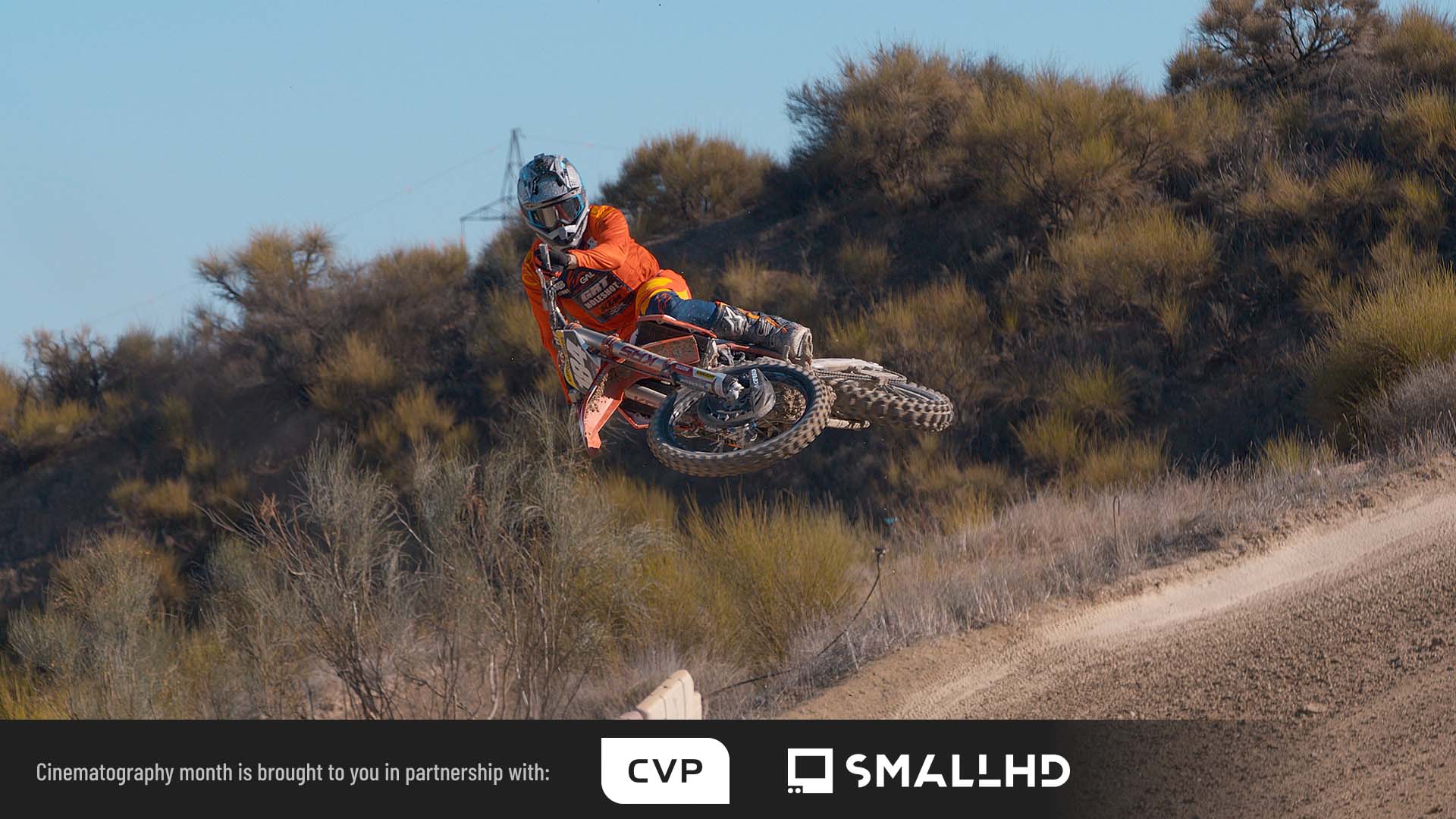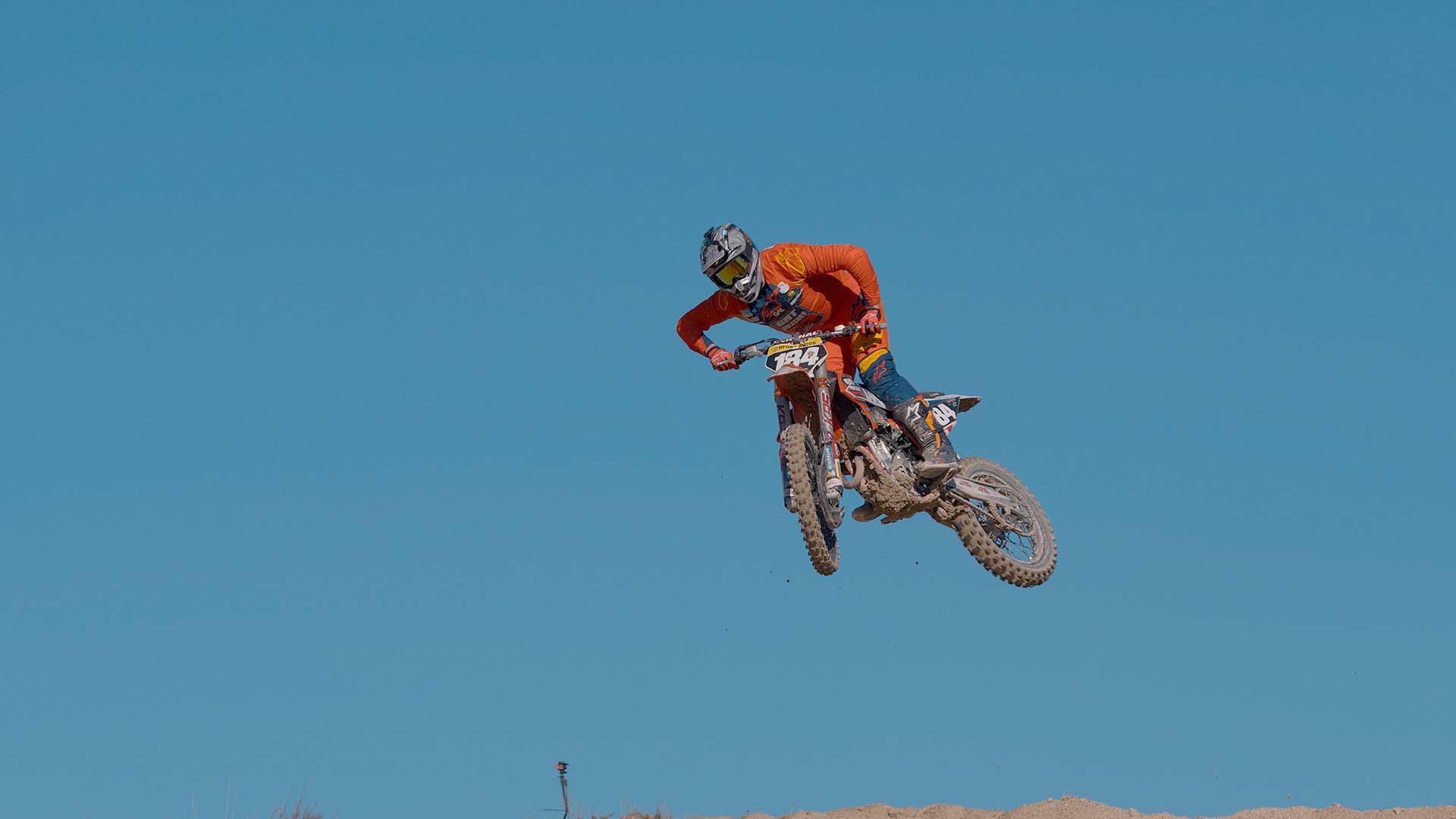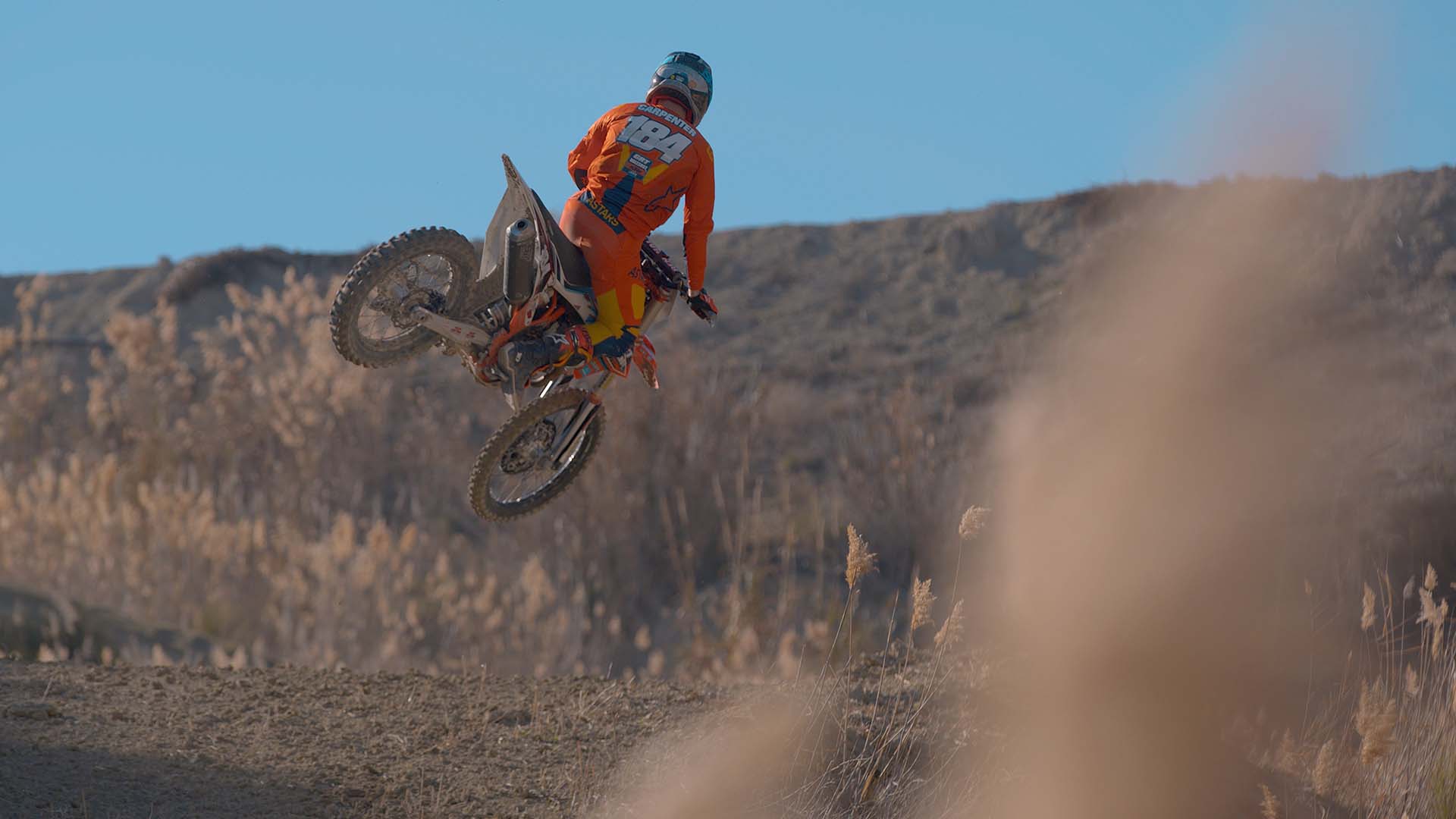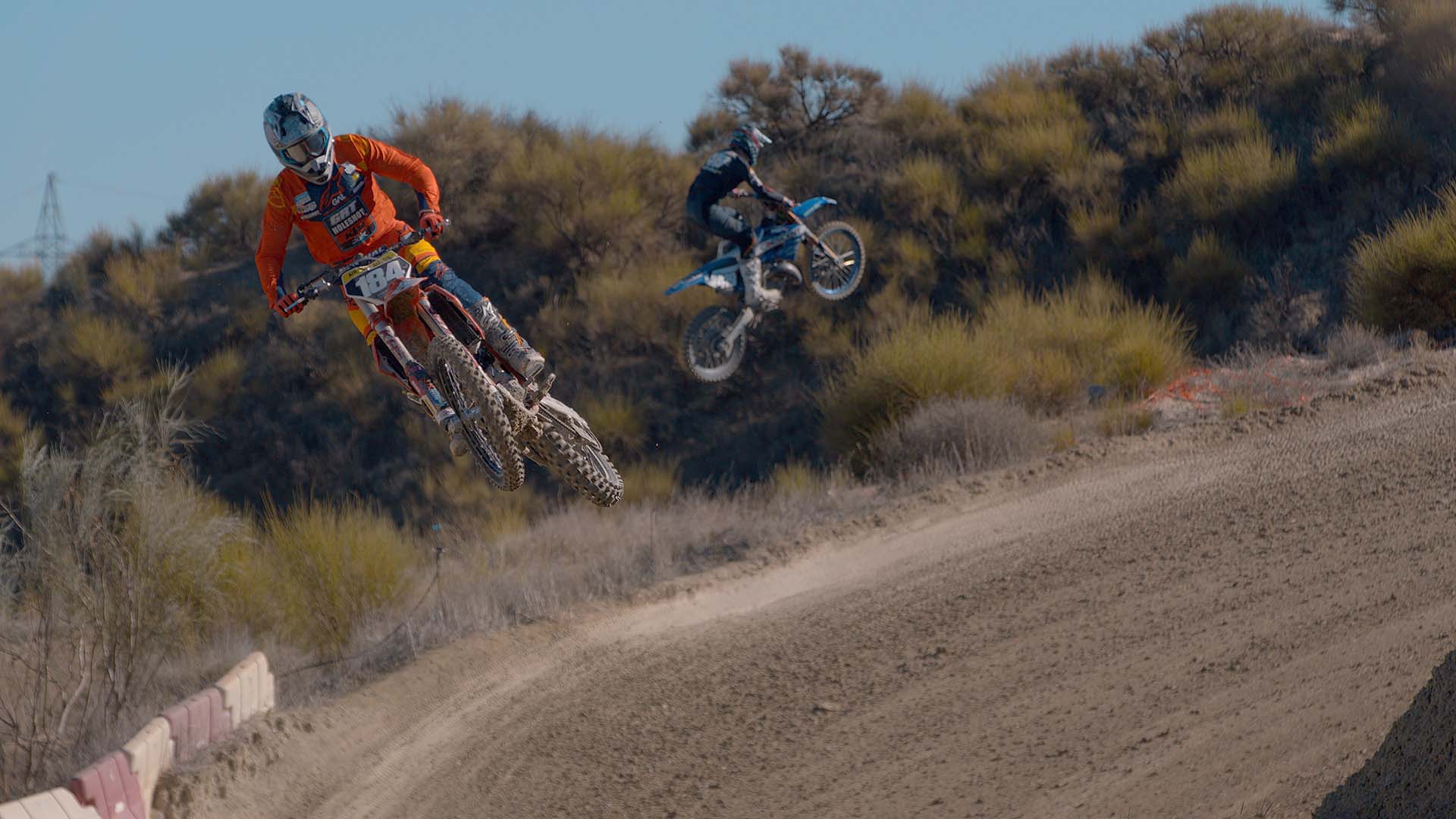
From muddy tracks in England to the sun-drenched dirt of Spain, extreme sports filmmaker, Anton Nelson, tells us how he used his Ursa Mini Pro 12K to film motocross rider Jamie Carpenter.
I want to make Jamie Carpenter look like a superhero. There isn't a single jump on that track where you can see the landing; if the riders can get over those jumps and not be afraid, nothing on the motocross competition circuit will scare them. From the framing and composition, everything I do is about perceiving these extraordinary athletes in the same way you would Superman. It is about the absolute art of that athletic performance.
I shot my video of Jamie in January, but I met him over a year before, far from the dust of the arid Spanish mountains. Capturing this kind of athletic performance became difficult, with the world in lockdown for much of the last two years. I'm excited by everything to do with athletics, performance and people, and suddenly all of these worlds were cut off. I wanted to keep my camera skills fresh, so during the brief times when we were allowed out of the house, I reached out to work with different athletes across different sporting spectrums. But it was the UK motocross scene that excited me the most.
The scene is small in the UK, but I found that on any given Wednesday or Saturday morning, I could travel to a local track and watch people perform and ride, and have a great time. And that is how I met Jamie Carpenter.
When I met him, he was a privateer; someone who doesn't ride with a team. He is a person who pulls together as many sponsors as possible. At the time, he must have had 50 logos on his van, as he was getting ready to ride for the season. Guys like Jamie realise that content is king.

Motocross rider, Jamie Carpenter, takes flight. Image: Anton Nelson.
Enter the Ursa Mini Pro 12K
Roll on to January 2022, and Jamie had now joined a team, and I went to film him for a few days at a training camp in southern Spain. It is a stunning environment and made an excellent backdrop for me to film. You have never seen such an incredible location for a conventional motocross track.
For four days, I shot Jamie with the Ursa Mini Pro 12K.
When I use the camera, I expose to get the maximum latitude out of the footage so that I can stretch and strain a video codec. I guess that comes from my training as an illustrator and designer, which still influences my work. The 12K sensor allows me to play with 14-stops of dynamic range, high frame rates and a raw codec that enables me to get every bit of detail from the sensor. It gives me capabilities that I don't have with any other camera.
There is a shot in the film of Jamie popping over a jump. I shot it with a 70-200mm lens in 8K at 120fps. He's just whipping the bike over the jump, and it looks incredible. I was so happy when I filmed that as I knew I had it in focus, but it wasn't until I got back, put it into DaVinci Resolve and saw the detail that it struck me what I had captured. It's a 38-megapixel frame, and there are 120 of them! I can pull any one of those frames up, and it has enough detail to print for a billboard! That, for me, was a big moment.

Image: Anton Nelson.
A lot of content I produce gets used across many different platforms, but the Ursa Mini Pro 12K means that I can shoot everything I need with just one camera. I've adjusted my style of framing to shoot much wider in camera. I shoot wide as it means that I can produce a 9:16 video for TikTok or Instagram Reels and still produce a standard 16:9 edit for YouTube and a 1:1 square for Instagram's feed or Facebook. Having that ultra-high-resolution 12k master means that there is no compromise on image quality.
I also need a camera that is going to be maneuverable. The environments I work in, such as in this video, can be dusty, or I could be on wet, icy ground. I want to get close enough for those low angle fisheye shots, but I don't want to get so close I get hit by one of the bikes. I do push the cameras. They're not sealed like weatherproof cameras, but that doesn't mean you have to treat them with kid gloves. I had to shoot a drift meeting on a rainy day, and the only way I protected the camera was by sticking a plastic bag on top of it. I didn't do anything else, and we kept shooting the whole day. It’s got an excellent robust build. It's a rough and tumble kind of sport that gives a lot of transferable skills to other things I shoot.
Having built-in ND filters is another big bonus for me. It means that I don't have to lug heavy matte boxes around. Again, it all comes down to what you can squeeze from the sensor. Having a high dynamic range allows me to make sure I'm capturing every logo in every possible lighting environment. There is another shot towards the end of the video, taken towards the end of the day. Jamie is whipping his bike around the track, with the sun fairly low and shining through some of the vegetation. I knew Jamie would be in shadow, and I was concerned about how it would look, but with the cameras dynamic range, you can clearly see every number and logo on his top; details like these are so important to a motorsport’s client.

Image: Anton Nelson.
Lenses used
For this shoot, I used a mixture of Canon telephoto lenses and primes. I have a set of 20mm, 24mm, 40mm and 50mm Sigma prime lenses and the Sigma 18-35mm f/1.8. I also used a beautiful 10mm Samyang lens, creating an insanely wide image on a Super35 sensor. They are all photo lenses as I want to travel light - I usually only want to take one backpack if I can. I love that Sigma's photography lenses are the same optical quality as its cine range. The photo lenses are smaller and lighter, so I can pack more options in a single bag. I'm horrible like that; I'll bring four primes to shoot motocross on a dusty track rather than take a zoom lens or two - I do it the wrong way around. In the end, I think it is a testament to the look of the work.
I just want to make beautiful content. Motocross is a great example. There's not much money in it, but I'm passionate about it. It's my personal project. I'll do two or three Motocross edits this year because I love doing it. And I want to give that same cinematic feel as all of my work.
I'm known for making very aggressive work with hard, short, cuts. You'll see a beautifully framed image that is like a photograph, but then it's gone. And then there are ten more shots like that within a few seconds. I think it comes from years spent working with music artists; I learned to make videos cutting to the beat. Everything is about anticipation and energy, speed and aggression, and it's appropriate to the sports that I shoot.
I don't make yoga videos.

Tags: Production cinematography

Comments